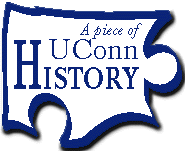This is an archived article. For the latest news, go to the Advance Homepage. For more archives, go to the Advance Archive/Search Page  | ||
|
Charles Beach advocated state funding for building plan, launched art collection
When he suffered a cerebral hemorrhage on September 1, "the Storrs community was profoundly shocked and saddened," said James H. Barnett, emeritus professor of sociology, in a 1969 sketch about the former president.
Beach's legacy is still felt through the building that bears his name: Beach Hall, opened in 1929 as home to the college's science programs; through the art collection he began in 1924, that became the basis for the permanent collection of the William Benton Museum of Art; and through the Charles L. Beach Society, which recognizes people who have remembered the University in their estate plans. Beach was president from 1908 to 1928, but he had also been on the faculty of the college from 1896 to 1906. During the two years away from Storrs he was a professor of dairy husbandry at the University of Vermont. When he returned to Storrs, he "found the physical plant badly in need of expansion, and both educational standards and faculty morale were low," said Barnett. Making his first report to the Connecticut General Assembly, Beach outlined a building plan titled "Needs of the College." "Throughout the 20 years in which Mr. Beach served as president ... the outstanding fact was the persistence with which he returned with each new session of the General Assembly to his carefully formulated plan for building up the institution," wrote Walter Stemmons in his history of the first half-century of the University. One of the first buildings approved was a new dining hall to replace the overcrowded facility in Old Main, the 1890 wooden structure that housed much of the fledgling college. Beach had asked for $30,000 in construction funds. The legislature approved $12,500 and trustees decided to plan the building so that it could house the mechanic arts program. Built on North Eagleville Road across from the Duck Pond (now known as Swan Lake), it would have many uses in the years to come. In 1922 it was the first home of the college's radio station, WABL (later WCAC and, since 1947, WHUS.) It would also house the music program and much later it became home to the Admissions Office and Personnel (now Human Resources). The current tenant is the Office of Institutional Research. By 1918, the dining facility in the Mechanic Arts Building was overcrowded. Beach requested funding for a new dining hall, and following legislative approval, the new facility opened in 1920. Affectionately called "the Beanery," it soon became central to campus life. A recurring theme during the tenure of Charles Beach as president was controversy about the future of the college in Storrs. The debate came down to whether it would be "cultural or agricultural." Newspaper editorials questioned why farmers needed courses on English literature or language studies in German, French and Spanish. The debate reopened arguments that had raged in the 1890s when Storrs Agricultural School took the name Storrs Agricultural College. Beach fought back, with support from farm interests throughout the state, even as he continued to fight each year for appropriations from the legislature. At that time, Beach was known to have "considerable interest in the humanities and especially in poetry," but he had not shown an interest in painting. "The mutual devotion of Charles Beach and Louise Crombie Beach was probably the origin of Mr. Beach's early purchases of a few pictures to please his wife when she was recovering from an illness," wrote Barnett in 1969. "He began to buy pictures in 1924 and after Mrs. Beach's death that year he became a close student and collector of painting. In 1925 he commissioned Ellen Emmet Rand to do a posthumous painting of Mrs. Beach from photographs, and this well-known picture is in the Beach Collection at Storrs," Barnett said. Beach continued to buy paintings, and in 1929 he established the Louise Crombie Beach Foundation which was authorized to use funds designated in his will for future purchases. He gave the collection to the college, and pieces were hung in buildings throughout the campus. Nearly 30 years later, the collection found a permanent home in the building known as the Beanery. Opened in 1967 as the University Museum of Art, it became the William Benton Museum of Art in the early 1970s. The Benton is celebrating its 30th anniversary this fall and winter with an exhibition that includes works from the permanent collection and new acquisitions. Mark J. Roy Sources: Mr. Beach: A Profile of Charles Lewis Beach, James H. Barnett, 1969, University of Connecticut Publications Series; Connecticut Agricultural College - A History, Walter Stemmons, 1930; unpublished manuscript, Evan Hill, 1980. |


